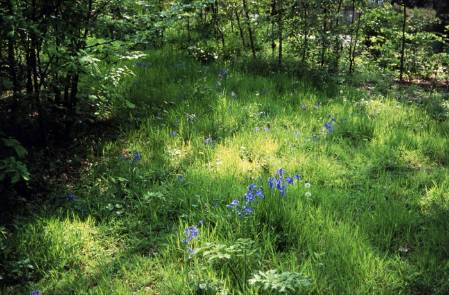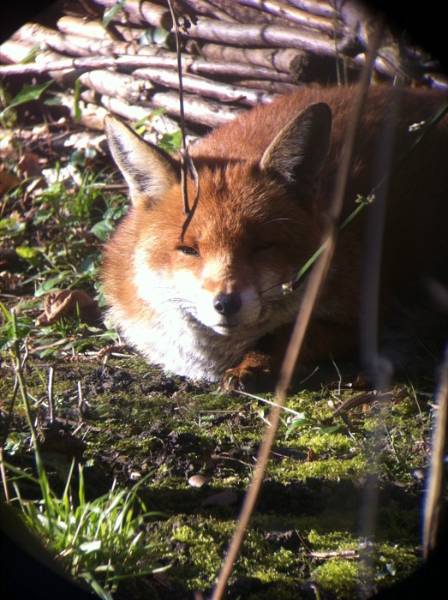The rich warbling song of the blackcap has welcomed us into work over the past 2 weeks! (you can hear an Eurasian blackcap, Sylvia atricapilla, as recorded by Patrick Aberg here). Not only that but we've had robins nesting just above the threshold of our shed with the accompanying chatter of baby birds anticipating food, holly blue butterflies visiting clusters of fresh holly flowers, sightings of orange tip, brimstone, peacock and speckled wood butterflies, tadpoles in the main pond, the occasional glimpse of a fox cub, and many more signs that Spring has well and truly sprung.
A speckled wood (Pararge aegeria) resting on false brome - one of its larval food plants.
The mosaic of ground flora throughout the different habitats in the Garden is changing by the day with a particular blue haze and glorious scent of bluebells in the woodland areas.
Bluebells in our Wildlife Garden.
Note the spread compared to 12 years ago, below, when the woodland glade was less open than it is today.
Woodland glade in 2003.
But how many of them are the native British species (Hyacinthoides non-scripta) rather than hybrids or the invasive Spanish bluebell (Hyacinthoides hispanica)? The scented plants for sure, but what about their relatives?
Museum Botanist, Fred Rumsey explains some interbreeding:
"It's that time of the year again when our woods turn azure with one of our favourite wild-flowers. The cool dry winter has held things back; results from the Museum's online survey on flowering times has shown that over the last few years flowering has in some years commenced almost a month later than in some others, the variation making predictions as to the effects of global warming more difficult.
For some weeks the show has been building in the Wildlife Garden, where, in spite of our best efforts, the majority of our plants show the influence of Spanish bluebells. In this respect our Garden is typical of urban gardens throughout Britain.
The two bluebells are genetically very similar with their distinctions maintained only by their geographic isolation, because they interbreed freely where they meet and the vigorous hybrids are confusingly intermediate in all respects.
Spanish bluebell Hyacinthoides hispanica in an urban garden in south London.
© Naomi Lake
Three hundred years of British gardening has undone several thousand years of glorious isolation - Pandora's potting shed door can't now be closed but we can all act responsibly to prevent further spread into the truly wild places as yet unsullied by the paler-flowered, scentless, blue-pollened invader. In the meantime I will still appreciate the spectacle in our Garden, they may not all be 'pure' but they are still beautiful!"
More bluebells in our Wildlife Garden.
Thank you Fred! You can hear more from him on the main differences between bluebell species in the video on our website.
And in the past week I have been out and about in the woods admiring pure blooming bluebells and contributing to the Museum's bluebell survey. Here are some May Day highlights from woodland near Ashford in Kent:
A magnificent display of bluebells in Hunt's Wood, near Woodchurch
© Peter Buckley
Another brilliant display - something for us to aim for in our own Wildlife Garden.
© Peter Buckley
You too can help us with our research by contributing to the Museum's bluebell survey.
And finally, a small diversion: although our fox cubs are shy, the adult male is more relaxed, spending time around the pond banks to the delight of our visitors, but not so to our nesting moorhens.
Our male fox relaxing in the Wildlife Garden.
© Daniel Osborne





.jpg)
